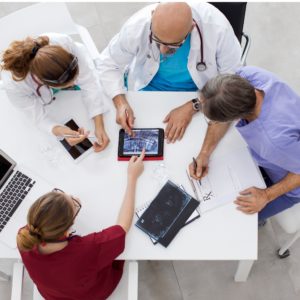Interventional Care


We notice that you are visiting us from . This site only services US-based visitors. Would you like to visit the site that is appropriate for your location?

As the healthcare industry still grapples with COVID-19 and the surging Delta variant, it is important to periodically assess our experiences and keep informed of the challenging and ever-changing landscape. Industry meetings, news reports, and publications help keep our clinical team up-to-date on the latest research, best practices, and guidance from experts including the Centers for Disease Control and Prevention (CDC). Below is an overview of some recent learnings to help steer infection prevention professionals, healthcare professionals, and facilities managers as they continue to navigate the fast-moving infection prevention environment.
Cleaning professionals often report difficulties involving streamlining and compliance with products and procedures used to keep patients safe in hospitals and other healthcare facilities. In typical settings, cleaners have various protocols and products to clean and disinfect each area, which can lead to utilizing a range of different chemicals as well as costly, confusing workflows. Today, COVID-19 guidance adds even more standards and requirements to incorporate into everyday cleaning practices.
One health system offered a real-world example of tackling a range of problems in their cleaning and disinfecting with an organization-wide performance improvement project. The system’s standard, pre-project processes included eight different low-level disinfectants being used by frontline staff; equipment manuals and cleaning/disinfection instructions for use (IFUs) that were not easily accessible; no clear “ownership” of who should be cleaning the different pieces of equipment; unclear instructions for contact times; and non-standard visual reminders of when equipment is marked “cleaned” versus “dirty”.
The health system incorporated top to bottom improvements, which resulted in several best practices to follow, including:
This example emphasizes the importance of simplifying disinfectant formularies, end-user ownership, and education on when and how to effectively clean and disinfect non-critical surfaces and patient care equipment. Training and establishing easy-to-follow procedures will lead to meeting key patient safety goals for infection prevention and greater confidence that we are doing right by our patients.
“Project Firstline” is a new CDC program aimed at developing and deploying infection prevention training collaboratives across healthcare settings to prepare frontline healthcare professionals and the public health workforce to protect themselves, their patients, and their communities.
CDC is teaming with academic and professional partners (including the American Medical Association, American Academy of Pediatrics, American Nurses Association), and state and local health departments to develop interactive and empowering infection prevention and control (IPC) training that will improve our nation’s health. Infection prevention is everyone’s business; it’s what healthcare professionals must do all the time. Empowerment, communication, and consistency are essential for protecting patients and staff. Find resources, videos, and more information on the CDC Project Frontline site.
The future of infection tracking and data surveillance in long-term care (LTC) facilities has been fundamentally changed with the onset of the pandemic. The CDC’s National Healthcare Safety Network (NHSN), which is the nation’s most widely used healthcare-associated infection tracking system, now requires LTC facilities to report its data under the COVID-19 module. The NHSN provides facilities, states, regions, and the nation with data needed to identify problem areas, measure the progress of prevention efforts, and ultimately eliminate healthcare-associated infections. Before 2020, there was no mandatory reporting requirement (as there was for acute care), instead, facilities voluntarily participated.
The NHSN platform has helped standardize timely data needed to inform a public health response at a national, local, and facility level. Now that all LTC facilities are established in the NHSN and reporting under the COVID-19 module, it is very likely that requirements will expand to include other reporting modules – such as urinary tract infections, multidrug-resistant organisms (MDROs) including Clostridioides difficile (C. diff), PPE/hand hygiene adherence, and vaccinations.
The participation of LTC facilities in reporting this wide range of important data will lead to standardized definitions and national benchmark comparisons to help inform and drive interventions for infection prevention at a facility level. It will allow transparency and access to accurate and verifiable patient safety data using standard definitions by government agencies, purchasers, and the public; and ultimately improve outcomes of care.
A recent study within an urban hospital setting performed a retrospective comparison of hospital-onset (HO) C. diff infection (CDI) rates during a three-month interval pre- and post-COVID (March to May in 2019 and 2020). It concluded COVID-19 safety measures implemented may have helped to keep CDI from increasing.
Measures, including enhanced cleaning and disinfection, improved hand hygiene practices, frequent rounding by infection prevention and environmental services, regular restocking of cleaning supplies, adherence to using of personal protection equipment (PPE) with special attention to glove use and hand hygiene, may have been instrumental with curbing CDI rates.
As the healthcare industry continues to move forward facing ongoing COVID-19 challenges, it helps to be armed with new developments and insights from infection prevention professionals. Stay tuned for our next PDI Perspectives edition with insights on emerging technologies in infection prevention.
Sources:
How Do You Know Your Equipment Is Clean: One Health System’s Experience (APIC 2021)
CDC Guidelines: https://www.cdc.gov/infectioncontrol/projectfirstline/index.html
How the SARS-COV-2 Pandemic Changed the Future of Long-term Care Infection Surveillance (APIC 2021)
Rates of Clostridioides difficile at an Urban Hospital During Initial COVID Pandemic Wave (APIC 2021)